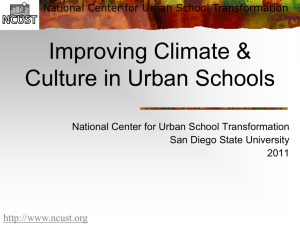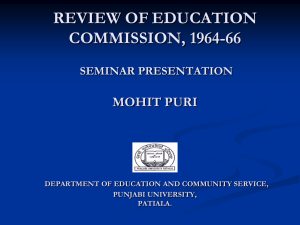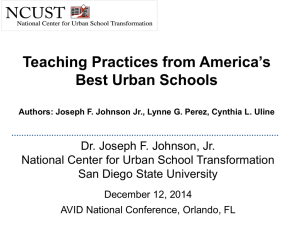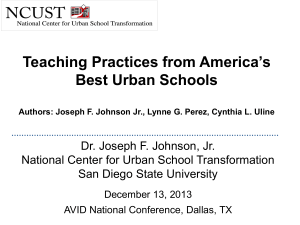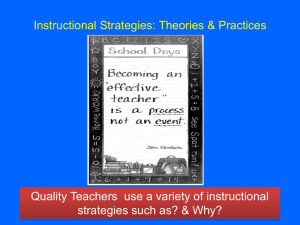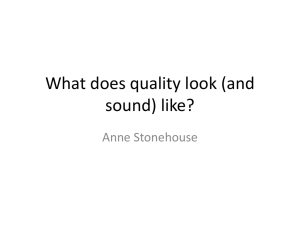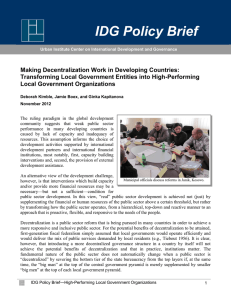to full PowerPoint presentation
advertisement
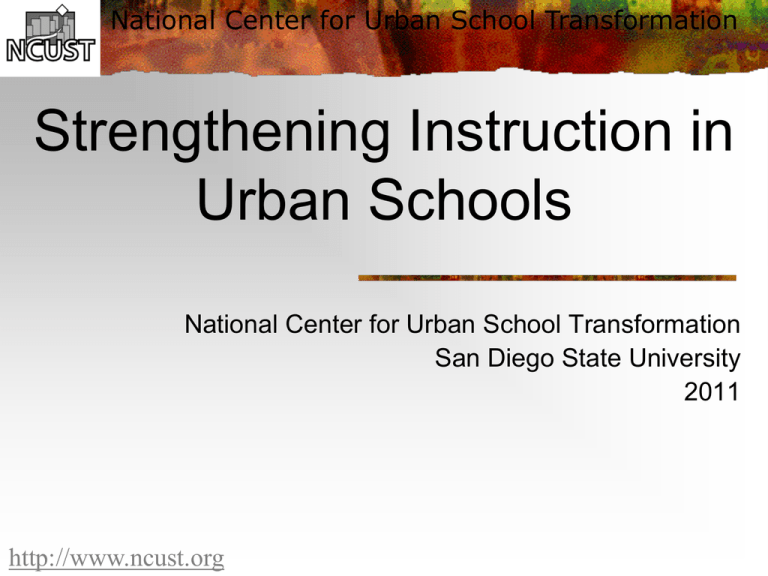
National Center for Urban School Transformation Strengthening Instruction in Urban Schools National Center for Urban School Transformation San Diego State University 2011 http://www.ncust.org National Center for Urban School Transformation Dedicated to identifying, studying, and promoting the best practices of America’s highest achieving urban schools in a manner that supports urban districts in transforming teaching and learning http://www.ncust.org Learn more at the Annual Symposium on High-Performing Urban Schools in San Diego, CA – May, 2012 In high-performing schools, instruction is focused upon generating student mastery Instruction in High-Performing Schools: Focusing on Mastery In excellent lessons, educators: Create clarity and specificity about what students are expected to learn Minimize transitions, wait time, and time off task Focus persistently on the objective to be mastered Focus on generating substantial depth of understanding (higher-order thinking) Strive to get every student to demonstrate mastery of the objective Instruction in High-Performing Schools: Acquiring Evidence of Understanding In excellent lessons, educators: Do not “chicken feed” (simply toss out information and hope students digest it) Engage all students in demonstrating their levels of understanding throughout the lesson Attend carefully to evidence of student understanding throughout the lesson Adapt instruction when student mastery is not evidenced Conclude by checking student understanding Instruction in High-Performing Schools: Presenting Information In excellent lessons, educators: Know the content they intend to teach Present key concepts in an organized manner, based on a logical task analysis Teach strategies so students can acquire information on their own Keep presentations of information brief Wait to present a second concept until students demonstrate that they understand the first concept Instruction in High-Performing Schools: Connecting with Students In excellent lessons, educators: Present key concepts in ways that build upon students’ background, culture, and interests Present key concepts in ways that build upon students’ prior knowledge Recognize when students are not understanding and find other ways to explain concepts when necessary Scaffold down and enrich upward based on levels of student understanding Instruction in High-Performing Schools: Building Critical Vocabulary In excellent lessons, educators: Pre-identify key vocabulary that influences understanding of the lesson content Provide multiple opportunities for all students to practice using key lesson vocabulary in their own spoken language Instruction in High-Performing Schools: Promoting Successful Practice In excellent lessons, educators: Allow students to practice independently only when there is substantial evidence that independent practice will be meaningful and successful Monitor independent practice (and/or give students ways to monitor their own practice) and intervene when necessary Instruction in High-Performing Schools: Making Students Feel Valued In excellent lessons, educators: Maintain a clean, attractive classroom Express a genuine interest in each student’s ideas Demonstrate courtesy and respect in all interactions Provide specific, meaningful praise in response to student effort Post high-quality student work frequently Give students the tools needed to evaluate the quality of their work (rubrics) Provide visual aids that can help students succeed Instruction in High-Performing Schools: Leading Students to Love Learning In excellent lessons, educators: Help students understand the importance of the content to be learned Demonstrate enthusiasm for the content Provide opportunities for students to use technology and/or manipulate objects in ways that reinforce lesson objectives Integrate material from other disciplines in teaching lesson objectives Provide students leadership opportunities Encourage student-to-student interaction How Do High-Performing Schools Build and Sustain Instructional Effectiveness? 1. Leaders pay close attention to instructional quality. Leaders visit classrooms frequently to gauge student learning. They constantly seek evidence that students are learning what their teachers are teaching. Regularly, leaders share this evidence in ways that build the capacity of teachers from day to day, creating a culture of professional growth. How Do High-Performing Schools Build and Sustain Instructional Effectiveness? 2. Leaders help educators support each other in learning how to teach students more effectively and efficiently. Leaders provide time and support in a manner that helps educators learn that one of their primary roles is to support the ongoing learning of their colleagues. How Do High-Performing Schools Build and Sustain Instructional Effectiveness? 3. Leaders help educators focus on one or two instructional issues at a time. Leaders don’t ask educators to do everything at once. They work with their teachers to develop mastery on one or two practices at a time. They don’t shift focus until a high rate of mastery has been achieved. How Do High-Performing Schools Build and Sustain Instructional Effectiveness? 4. Leaders help everyone remember that learning should be interesting and exciting. Leaders help educators teach in ways that students like to learn. They encourage teachers to build upon students interests, backgrounds, cultures, and prior knowledge. They help educators consider how they can make learning enjoyable. How Do High-Performing Schools Build and Sustain Instructional Effectiveness? 5. Improvement is rewarded. Lack of improvement is not. Lack of effort is not tolerated. Leaders communicate their passion to transform relationships, teaching, and learning through their actions. They reward improvement efforts and they make clear that a lack of effort is unacceptable.
